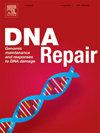胞质DNA和细胞内Ca2+:在复制胁迫下维持基因组的稳定性
IF 2.7
3区 生物学
Q2 GENETICS & HEREDITY
引用次数: 0
摘要
在DNA复制过程中保持基因组的稳定性是一个关键的细胞挑战。多种监视和修复机制已经发展到应对复制应激,这可能是由环境损害、代谢副产物、基因组中复杂的DNA结构和复制-转录冲突引起的。这一观点强调了新发现的细胞质DNA/Ca2+依赖信号通路,在保护停滞的复制分叉中起着至关重要的作用。该途径涉及胞质DNA的产生及其通过cGAS-cGAMP-STING轴的感知,trpv2介导的内质网Ca2+释放,以及抑制EXO1核酸酶的CaMKK2-AMPK蛋白磷酸化级联的激活,从而防止异常叉加工并保持染色体完整性。与ATR/Chk1检查点分离,这种细胞dna /Ca2+依赖途径代表了基因组维持的非冗余机制,对癌症的形成及其治疗具有潜在的重要意义。此外,该通路与其他信号网络的交叉也使基因组维持、免疫反应、自噬和细胞衰老的协调调节成为可能。本文章由计算机程序翻译,如有差异,请以英文原文为准。
Cytosolic DNA and intracellular Ca2+: Maintaining genome stability during replication stress
Maintaining genome stability during DNA replication is a critical cellular challenge. Various surveillance and repair mechanisms have evolved to cope with replication stress, which can be caused by environmental insults, metabolic byproducts, complex DNA structures in the genome, and replication-transcription conflicts. This perspective highlights a newly identified cytosolic DNA/Ca2+-dependent signaling pathway that plays a crucial role in protecting stalled replication forks. The pathway involves cytosolic DNA generation and its sensing by the cGAS-cGAMP-STING axis, TRPV2-mediated Ca2+ release from the ER, and activation of a CaMKK2-AMPK protein phosphorylation cascade that suppresses the EXO1 nuclease, thereby preventing aberrant fork processing and preserving chromosomal integrity. Separate from the ATR/Chk1 checkpoint, this cytoDNA/Ca2+-dependent pathway represents a non-redundant mechanism for genome maintenance, with potentially important implications for cancer formation and its treatment. Moreover, the intersection of this pathway with other signaling networks also enables coordinated regulation of genome maintenance, immune response, autophagy, and cellular senescence.
求助全文
通过发布文献求助,成功后即可免费获取论文全文。
去求助
来源期刊

DNA Repair
生物-毒理学
CiteScore
7.60
自引率
5.30%
发文量
91
审稿时长
59 days
期刊介绍:
DNA Repair provides a forum for the comprehensive coverage of DNA repair and cellular responses to DNA damage. The journal publishes original observations on genetic, cellular, biochemical, structural and molecular aspects of DNA repair, mutagenesis, cell cycle regulation, apoptosis and other biological responses in cells exposed to genomic insult, as well as their relationship to human disease.
DNA Repair publishes full-length research articles, brief reports on research, and reviews. The journal welcomes articles describing databases, methods and new technologies supporting research on DNA repair and responses to DNA damage. Letters to the Editor, hot topics and classics in DNA repair, historical reflections, book reviews and meeting reports also will be considered for publication.
 求助内容:
求助内容: 应助结果提醒方式:
应助结果提醒方式:


